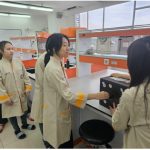Author: Jaclyn Regina Anggara
Have you ever noticed how someone can tell the difference between two foods that look almost identical but taste slightly different? In food science, that ability is called sensory sensitivity, and one of the main ways to measure it scientifically is through descriptive testing.
Descriptive testing is a method used to evaluate the sensory characteristics of a product, such as taste, aroma, color, and texture, in a structured and systematic way. Unlike a hedonic test, which focuses on whether people like a product or not, a descriptive test measures how strong and distinct each sensory attribute is perceived.
For example, panelists may be given several sugar solutions with different sweetness levels. They are then asked to rank or score them from the weakest to the strongest. From these results, researchers can observe how sharp each person’s sense of taste is and identify significant differences between samples.
Interestingly, this method not only trains sensory accuracy but also helps in developing trained panelists, individuals capable of evaluating products objectively and consistently. In the food industry, trained panelists play a vital role in ensuring that new products have balanced flavors and meet consumer expectations before reaching the market.
Through descriptive testing, we learn that a food product’s success isn’t determined solely by its recipe or ingredients but also by how consumers perceive and experience it. That’s why sensory skills are such an important foundation for future food technologists.
Curious to learn more about descriptive testing and its applications in the food industry? Join Ciputra University’s Food Technology Program! Here, you’ll gain hands-on experience with sensory evaluation methods through the Food Product Development course.





